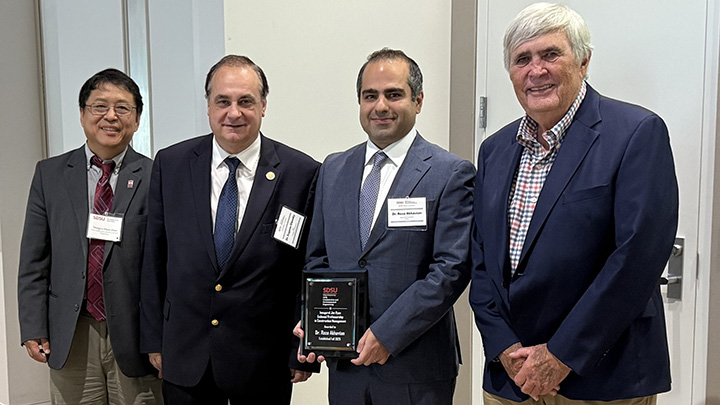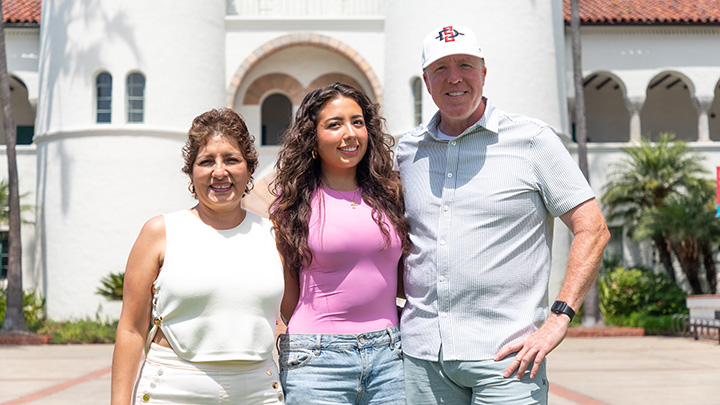The River as a Resource
SDSUs vision for Mission Valley includes expansive open space that will revitalize the San Diego River.

“Through strong interdisciplinary collaborations, SDSU is already leading a number of exciting research projects at the San Diego River.”
View the full SDSU Mission Valley site plan and architectural concepts at www.sdsu.edu/missionvalley.
This story appears in the fall 2018 issue of 360: The Magazine of San Diego State University.
You wouldn’t know it from its bone-dry state throughout most of the year, but San Diego’s Mission Valley is a floodplain.
Flooding is a perennial problem for SDCCU Stadium, previously known as Qualcomm Stadium, which was built in 1967 at the convergence of the San Diego River and Murphy Canyon Creek. Due to improper planning and rerouting of existing waterways, when big storms roll through, the San Diego River jumps its banks and the stadium’s enormous parking lot becomes a blacktop lake surrounding an inundated playing field.
While occasional floods are a natural part of the valley ecosystem, they need not be so disruptive, said Gordon Carrier of the architecture firm Carrier Johnson + Culture, principal architect for San Diego State University’s Mission Valley site plan.
By incorporating a new, thoughtfully designed and implemented river park at the heart of the proposed campus, the university could better manage flooding, provide critical habitat space for wildlife, and connect the San Diego community to an underutilized resource with tremendous potential for both recreation and research.
River doctors
Monitoring the health of the river as it runs through San Diego’s heavily populated urban corridor requires the skills of experts. Natalie Mladenov, who holds the William E. Leonhard Jr. Chair in Civil and Environmental Engineering at SDSU, has her hands in several projects aimed at measuring and restoring the river’s health.
She and her colleagues are figuring out how restoration efforts can help mitigate the river’s sporadic flooding. Ideally, the river could one day be returned to a more natural state and become a point of pride for the city.
“The San Diego River is already an amenity in some places,” Mladenov said. “By restoring its beauty, we can bring the community back to the river and make it a landmark that people will want to visit.”
Working across disciplines with fellow engineers, geographers and water quality experts at SDSU, Mladenov is involved in projects related to flood mitigation, native vegetation restoration and seasonal low oxygen levels that may increase fish kills.
SDSU researchers have received support from the San Diego River Conservancy and the San Diego Regional Water Quality Control Board to study the human sources of contamination leading to elevated bacteria levels in the river, particularly during storm seasons.
“Through strong interdisciplinary collaborations, SDSU is already leading a number of exciting research projects at the San Diego River,” Mladenov said. “We are well positioned to take advantage of a central location on the river in Mission Valley and use it as a living-learning lab for our students.”
Community connection
The potential of the San Diego River was also at the heart of Carrier Johnson + Culture’s plan for SDSU Mission Valley. Architects looked at the site’s hydrology and floodplain dynamics before every other consideration, and let those factors guide decisions about land use and design.
“There are few, if any, opportunities to influence a region like this plan can influence San Diego. Mission Valley is really the epicenter of the entire community, and it’s immensely important to get it right,” Carrier said.
When builders broke ground for the stadium in 1965, they used concrete channels to divert the natural flow of Murphy Canyon Creek away from what became the stadium site. As a result, the artificial channel intersects with the San Diego River in an unnatural T-junction, meaning that water careens down the creek and sloshes violently into the river during storms, causing backups and flooding.
The SDSU Mission Valley river park plan would accommodate Murphy Canyon Creek’s overflow by allowing its waters to run into the river with less potential for flooding. Per its design, the flood basin will accept large surges of storm waters during seasonal storm events.
If the river does swell beyond its banks, strategically located recreational space will provide a buffer to prevent widespread flooding. That’s intentional, Carrier said.
The river park is part of nearly 90 acres of open space designated in the SDSU Mission Valley plan. In response to feedback by environmental interest groups like the Sierra Club, the park will incorporate retention areas known as bioswales that use natural vegetation to filter pollution and trash out of rainwater before it runs off into the river. These bioswales pull double-duty as important habitats for native plants.
While the original plans for the park incorporated a good deal of green space, community members wanted even more, so the architects replaced some athletic fields slated for the site’s southwestern corner with additional acres of protected habitat space.
The goal, said Martin Flores, director of landscape architecture and urban planning for Carrier Johnson + Culture, is for the river park to provide a connection between the community and the river that has never really existed before.
“We want to open the river up to the community, to retell the story of the river,” Flores said. “Every time I ride the trolley over the river now, I look down and imagine what it could be.”
View the full SDSU Mission Valley site plan and architectural concepts at www.sdsu.edu/missionvalley.


